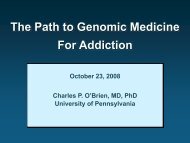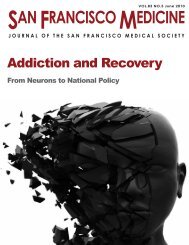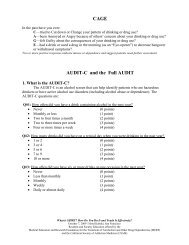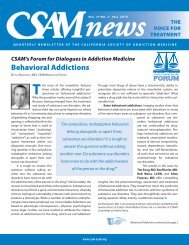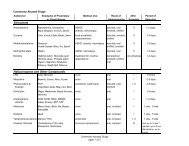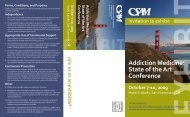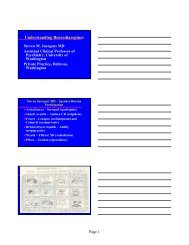Alcoholics Anonymous: cult or cure?
Alcoholics Anonymous: cult or cure?
Alcoholics Anonymous: cult or cure?
You also want an ePaper? Increase the reach of your titles
YUMPU automatically turns print PDFs into web optimized ePapers that Google loves.
432 ALCOHOLICS ANONYMOUS<br />
long-term studies that could prove – <strong>or</strong> disprove – the<br />
efficacy of these treatments still remain undone.<br />
The reasons f<strong>or</strong> the failure of professional therapy to<br />
prevent eventual relapse, and thus alter the natural hist<strong>or</strong>y<br />
of alcoholism, are twofold. First, the hold that drug addiction<br />
has on human beings does not rest in our c<strong>or</strong>tex.<br />
The hold of addiction on our minds lies in what has been<br />
called our reptile brain. The hold comes from cellular<br />
changes in midbrain nuclei like the nucleus accumbens<br />
and the superi<strong>or</strong> tegmentum. Eventually, loss of plasticity<br />
of neuronal response in these centres renders abstinence<br />
beyond the reach of willpower, beyond the reach<br />
of conditioning and beyond the reach of psychoanalytic<br />
insight.<br />
The second reason that often life-saving professional<br />
treatment fails to prevent relapse in alcoholism is the<br />
same reason that life-saving hospitalization fails to prevent<br />
relapse in diabetes. Change in clinical course in<br />
both alcoholism and diabetes can only be achieved by relapse<br />
prevention and to quote Lady Macbeth’s physician<br />
‘Therein the patient must minister to herself’.<br />
There are four fact<strong>or</strong>s that are commonly present in<br />
relapse prevention f<strong>or</strong> most addictions, be they smoking,<br />
compulsive eating, opiate addiction, gambling <strong>or</strong> alcoholism<br />
[11,12]. The four fact<strong>or</strong>s that prevent relapse are<br />
external supervision, ritual dependency on a competing<br />
behaviour, new love relationships and deepened spirituality.<br />
Usually, two <strong>or</strong> m<strong>or</strong>e fact<strong>or</strong>s must be present f<strong>or</strong><br />
relapse prevention to occur. The reason that these four<br />
fact<strong>or</strong>s are effective is probably because, unlike most<br />
professional treatments, they do not w<strong>or</strong>k to create temp<strong>or</strong>ary<br />
abstinence <strong>or</strong> reduced drinking. They w<strong>or</strong>k to<br />
effect relapse prevention; and, thus, like regularly selfadministered<br />
insulin in diabetics, they must be used f<strong>or</strong> a<br />
very long time. Elsewhere [7] I have stressed the congruence<br />
of these four fact<strong>or</strong>s with Marlatt’s [13] use<br />
of cognitive behavioural techniques to enhance relapse<br />
prevention.<br />
External supervision appears necessary because in<br />
prospective studies conscious motivation to stop drinking<br />
at admission is not associated with outcome [7]. <strong>Alcoholics</strong><br />
<strong>Anonymous</strong>, like most personal trainers, provides<br />
motivation from without and suggests that clients return<br />
again and again. In AA, members are told to find a spons<strong>or</strong><br />
to telephone and to visit often. They are encouraged<br />
to ‘w<strong>or</strong>k the steps’ and to engage in service. Each of these<br />
activities provides a daily involuntary reminder that alcohol<br />
is an enemy, not a friend. These activities provide<br />
external supervision, <strong>or</strong> in the language of AA ‘keep the<br />
mem<strong>or</strong>y green’. But AA also understands that compuls<strong>or</strong>y<br />
supervision w<strong>or</strong>ks best if it is from choice. We willingly<br />
suffer under the strict rules of our athletic coach,<br />
but we evade prohibitions of which we do not approve.<br />
Second, it is imp<strong>or</strong>tant to find a substitute dependency<br />
<strong>or</strong> a competing behaviour f<strong>or</strong> the addiction. You cannot<br />
easily give up a habit without having something else to<br />
do. F<strong>or</strong> example, disulfiram, often prescribed because<br />
it makes the ingestion of alcohol sickening, fails as a<br />
<strong>cure</strong> because although it takes alcohol away, disulfiram<br />
offers no replacement. Eventually the patient stops the<br />
medicine. However, competing dependencies – f<strong>or</strong> example,<br />
methadone maintenance in heroin abuse – facilitate<br />
relapse prevention because they offer a carrot as well as<br />
a stick. In contrast, imprisonment per se did not reduce<br />
relapse to heroin abuse [12]. F<strong>or</strong> punishment alone does<br />
not alter deeply ingrained habits.<br />
<strong>Alcoholics</strong> <strong>Anonymous</strong> understands what all behaviourists<br />
know and what many doct<strong>or</strong>s and parents<br />
f<strong>or</strong>get: bad habits need substitutes. <strong>Alcoholics</strong> <strong>Anonymous</strong><br />
provides not only supervision, but also a gratifying<br />
schedule of social and service activities in the presence of<br />
supp<strong>or</strong>tive and now-healed alcoholics, especially at times<br />
of high risk, like holidays.<br />
Third, new love relationships are imp<strong>or</strong>tant to recovery.<br />
It seems imp<strong>or</strong>tant f<strong>or</strong> ex-addicts to bond with people<br />
whom they have not hurt in the past and to whom they are<br />
not deeply emotionally in debt. Indeed, it helps f<strong>or</strong> them<br />
to bond with people whom they can actively help [14].<br />
<strong>Alcoholics</strong> <strong>Anonymous</strong> meetings are filled with sober<br />
f<strong>or</strong>mer pub-crawlers with whom to befriend but to whom<br />
one does not owe money. Similarly, an AA spons<strong>or</strong>, analogous<br />
to a new spouse, can promote relapse prevention<br />
better than some long-suffering family member whom<br />
they have t<strong>or</strong>tured f<strong>or</strong> years.<br />
As a speculative aside, since it is doubtful that our<br />
prehist<strong>or</strong>ic ancest<strong>or</strong>s shot dope, the brain circuitry underlying<br />
addiction may have evolved <strong>or</strong>iginally to facilitate<br />
human attachment, social cohesion and spiritual community<br />
[15]. Brain opiates are released during the attachment<br />
behaviours of social grooming and during the social<br />
bonding of mother rat–pup reunions [16,17].<br />
The fourth common feature in recovery from addiction,<br />
the discovery <strong>or</strong> rediscovery of spirituality, isthemost<br />
controversial. Inspirational, altruistic group membership<br />
and belief in a power greater than ‘me’ seems imp<strong>or</strong>tant<br />
to recovery from addiction. In The Varieties of Religious<br />
Experience, William James [18] first articulated<br />
the close relationship between religious conversion and<br />
recovery from intractable alcoholism. As Carl Jung [19]<br />
directed the cofounder of AA, Bill Wilson, ‘Spiritus contra<br />
spiritu’. The universal model that Jerome Frank [20]<br />
describes in his book, Persuasion and Healing, f<strong>or</strong> effective<br />
psychotherapy closely resembles spiritual healing. In<br />
Frank’s model the sanctioned healer should have that status<br />
(e.g. several years of abstinence), be equipped with an<br />
unambiguous conceptual model of the problem (e.g. AA’s




